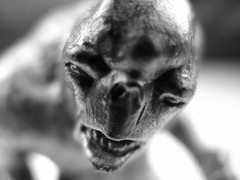 Guillermo del Toro's 2001 Spanish-language film The Devil's Backbone is a ghost story wherein ghosts get precious little screen time. Set against the backdrop of the Spanish Civil War, it features an orphanage with an undetonated bomb lodged in its courtyard; a fractious group of pre-adolescents constantly jockeying for position; a lovelorn administrator unable to secure the affection for which he longs; and a bitter laborer with a lust for wealth and frighteningly few scruples. Oh, yes, and there's also an unquiet spirit, but it disappears (no pun intended) for long stretches of the narrative.
Guillermo del Toro's 2001 Spanish-language film The Devil's Backbone is a ghost story wherein ghosts get precious little screen time. Set against the backdrop of the Spanish Civil War, it features an orphanage with an undetonated bomb lodged in its courtyard; a fractious group of pre-adolescents constantly jockeying for position; a lovelorn administrator unable to secure the affection for which he longs; and a bitter laborer with a lust for wealth and frighteningly few scruples. Oh, yes, and there's also an unquiet spirit, but it disappears (no pun intended) for long stretches of the narrative.You know what? That works pretty well. The Devil's Backbone understands that horror isn't ultimately about the monster. For it, greed, war, injustice and the slow fading of youthful vigor are the true terrors. The ghost serves the purpose of highlighting these themes. That's what the best horror does: It uses scary stuff to turn the focus to weightier matters such as the insidious nature of paranoia (John Carpenter's The Thing), the beauty of family and civilization (28 Days Later), and every individual's innate need for redemption (The Addiction).
Of course, many other works keep the focus squarely on the things that lurk in the shadows. The Ring fixated on its spooky young drowning victim, entirely glossing over its terrible conclusion that that perpetuating violence is justifiable if it keeps one's family safe. Cabin Fever obliquely dealt with whether or not forced quarantine is just, but mainly reveled in all the lovely things flesh-eating bacteria can do to the human body. And the A Nightmare on Elm Street and Friday the 13th franchises simply went straight for titillation with their scores of butchered coeds.
What's the difference between the two camps? Well, for me memorability is a big one. I can scarcely recall much of anything about the second set except a vague sense of boredom or disgust. So is a filmmaker's desire to tackle the stuff of real life. The first set tries to deal with universal human experience. Sure, its movies contain spooky set pieces and malicious monsters. But their creators are smart enough to know that such genre trappings are a story's spice, not its substance.
(Picture: CC 2008 by kevin dooley)


6 comments:
Strangely, The Ring was memorable for me, but I think it's the exception that proves the rule. Its cinematography, music, art direction, and sound effects were just so darned impressive that it turned a forgettable sub-genre of horror into a work of true craftsmanship, though not true art (whatever that means).
(I suppose that makes it the opposite of the Gaiman CGI Beowulf (of Angelina Jolie fame), which I would argue tried to do something really thoughtful, interesting, and cool but screwed up so much that it ended up being a dumb, incoherent mess.)
The second category and titillation explains why I've enjoyed fiction with a dollop of darkness and didn't realize that I'd enjoy reading/watching horror. Of course, my favorite way to consume it currently is to read in Swedish. The grisly stomach-turning parts are a little less memorable when they stray into the titillation realm.
Two of my favorites are THE HAUNTING and PICNIC AT HANGING ROCK where you see almost nothing and yet are terrified.
CR,
Man, I really, really hate The Ring, in part because it was so well-shot. It's like a lovely candy shell wrapped around a void, a beautiful artistic facade placed around thematic emptiness.
Aidan,
Have you seen Let the Right One In? I think you might really like it.
Patti,
That subtly always makes the best horror in my humble opinion. Sound is so important in horror films and can communicate tons apart from the visuals.
Post a Comment